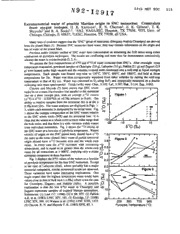
NASA Technical Reports Server (NTRS) 19920003699: Extraterrestrial water of possible Martian origin in SNC meteorites: Constraints from oxygen isotopes PDF
Preview NASA Technical Reports Server (NTRS) 19920003699: Extraterrestrial water of possible Martian origin in SNC meteorites: Constraints from oxygen isotopes
54th MET SOC 113 N92-12917 Extraterrestrial water of possible Martian origin in SNC meteorites: Constraints from oxygen isotopes. H. R. Karlsson 1, R. N. Clayton 2, E. K. Gibson 1, T. K. Maycda 2 and R. A. Socki 1.3. ISN2, NASA/JSC, Houston, TX 77058, 2EFI, Univ. of Chicago, Chicago, I1. 50537, 3LESC, Houston, TX 77058, all USA. Many lines of evidence suggest that the "SNC" group of meteorites (Shergotty-Nakhla-Chassigny) are derived from the planet Mars (1). Because SNC meteorites have water, they may contain information on the origin and fate of water on the planet Mars. Previous stable isotopic studies of SNC water have concentrated on measuring the DAI ratios using either combustion or pyrolysis techniques. The results are conflicting and none thus far demonstrates conclusively whether the water is extraterrestrial (2, 3,4). We present the first measurements of a180 and 8170 of water extracted from SNC's. After overnight room temperature evacuation, powdered samples ofChassigny (2.0 g), Lafayette (3.0 g), Nakhla (2.1 g) and Zagami (2.9 g) were heated under high vacuum and the volatiles evolved were condensed into a cold-trap atliquid nitrogen temperatures. Each sample was heated step-wise to 150"C, 350"C, 600"C and 1000"C, and held at those temperatures for lhr. Water was then cryogenically separated from other volatiles by raising the cold-trap temperature to that of dry ice. Water was converted to 02 using BrF5 and isotopieally measured on a double collecting ratio mass spectrometer. Yields (wt%) were: Chas., 0.102; Laf., 0.387; Nak., 0.114; Zag., 0.042. Clayton and Mayeda (5) have shown that SNC whole 10 rocks lie on a mass fractionation line parallel tothe terrestrial ' I ' I ' I _ line on a three isotope plot, with an average/070 excess (A170 = 5170 - 0.5251sO) of +0.3%0 relative to Earth. Our o ability to resolve samples from the terrestrial line is at the + 0.1%0level (2o). The water analyses are displayed inFigs. 1- O 0 3, where each meteorite is designated by its initial letter. Fig. 1 shows the isotopic composition of the SNC waters relative to the SNC whole rocks (WR) and the terrestrial line. It is clear that the waters as a whole cover a much wider range than -10 the bulk rocks, and that there isa wide variationwithin waters -2( -10 0 10 a"o (%0) from individual meteorites. Fig. 2 shows the ]70 excess of the SNC water as a function of pyrolysis temperature. Waters entirely of origin on the SNC patent body should have _]70 1.0L . , . , . , • , • the same as the rocks (dotted line); water of partial terrestrial _. Figure 2/ N e " origin should have AlTObetween zero and the whole-rock 0.8 temperature, and is equal to or greater than the whole-rock 0.6 L- value for all extractions at > 600"C, implying only a minor O 0.4 terrestrial component inthese fractions. Fig. 3displays the 5180values of the waters as a function _ voaflupey"rolyIsnisevteemrypercaatsuerethfeorAtth7e0foiunrcrSeNasCesmewteiothriteisn.creEaxsicnegpt °"7"0g.2 I_ i in the case of Lafayette (find), which probably has a major 0.0 Figure terrestrial component, similar downward trends are observed. 10 These variations have some interesting implications. One might expect that the highest temperature water would have o_ values close to that of bulk rock (-.+5%0) which is not the case _ 0 for Chassigny, Zagami, and Nakhla (falls). A possible explanation is that the low 5180 water in Chassigny and Zagami represents samples of trapped Martian atmosphere. References: (1) Laul J.C. (1986) GCA 50, 875. (2) Fallick A.E. et al. (1983) LPSC XIV, 183. (3) Kerridge, J.F. (1988) -20 LPSC XIX, 599. (4) Watson et al. (1991) LPSC XXII, 1473. 300 500 700 900 (5) Clayton, R. N. and Mayeda T. K. (1983) EPSL 62, 1. PyrolysisTemperature ('C)
